Nils Thuerey
Technical University of Munich
Neural Emulator Superiority: When Machine Learning for PDEs Surpasses its Training Data
Oct 27, 2025Abstract:Neural operators or emulators for PDEs trained on data from numerical solvers are conventionally assumed to be limited by their training data's fidelity. We challenge this assumption by identifying "emulator superiority," where neural networks trained purely on low-fidelity solver data can achieve higher accuracy than those solvers when evaluated against a higher-fidelity reference. Our theoretical analysis reveals how the interplay between emulator inductive biases, training objectives, and numerical error characteristics enables superior performance during multi-step rollouts. We empirically validate this finding across different PDEs using standard neural architectures, demonstrating that emulators can implicitly learn dynamics that are more regularized or exhibit more favorable error accumulation properties than their training data, potentially surpassing training data limitations and mitigating numerical artifacts. This work prompts a re-evaluation of emulator benchmarking, suggesting neural emulators might achieve greater physical fidelity than their training source within specific operational regimes. Project Page: https://tum-pbs.github.io/emulator-superiority
Flow Matching Meets PDEs: A Unified Framework for Physics-Constrained Generation
Jun 10, 2025Abstract:Generative machine learning methods, such as diffusion models and flow matching, have shown great potential in modeling complex system behaviors and building efficient surrogate models. However, these methods typically learn the underlying physics implicitly from data. We propose Physics-Based Flow Matching (PBFM), a novel generative framework that explicitly embeds physical constraints, both PDE residuals and algebraic relations, into the flow matching objective. We also introduce temporal unrolling at training time that improves the accuracy of the final, noise-free sample prediction. Our method jointly minimizes the flow matching loss and the physics-based residual loss without requiring hyperparameter tuning of their relative weights. Additionally, we analyze the role of the minimum noise level, $\sigma_{\min}$, in the context of physical constraints and evaluate a stochastic sampling strategy that helps to reduce physical residuals. Through extensive benchmarks on three representative PDE problems, we show that our approach yields up to an $8\times$ more accurate physical residuals compared to FM, while clearly outperforming existing algorithms in terms of distributional accuracy. PBFM thus provides a principled and efficient framework for surrogate modeling, uncertainty quantification, and accelerated simulation in physics and engineering applications.
PDE-Transformer: Efficient and Versatile Transformers for Physics Simulations
May 30, 2025Abstract:We introduce PDE-Transformer, an improved transformer-based architecture for surrogate modeling of physics simulations on regular grids. We combine recent architectural improvements of diffusion transformers with adjustments specific for large-scale simulations to yield a more scalable and versatile general-purpose transformer architecture, which can be used as the backbone for building large-scale foundation models in physical sciences. We demonstrate that our proposed architecture outperforms state-of-the-art transformer architectures for computer vision on a large dataset of 16 different types of PDEs. We propose to embed different physical channels individually as spatio-temporal tokens, which interact via channel-wise self-attention. This helps to maintain a consistent information density of tokens when learning multiple types of PDEs simultaneously. We demonstrate that our pre-trained models achieve improved performance on several challenging downstream tasks compared to training from scratch and also beat other foundation model architectures for physics simulations.
PICT -- A Differentiable, GPU-Accelerated Multi-Block PISO Solver for Simulation-Coupled Learning Tasks in Fluid Dynamics
May 22, 2025

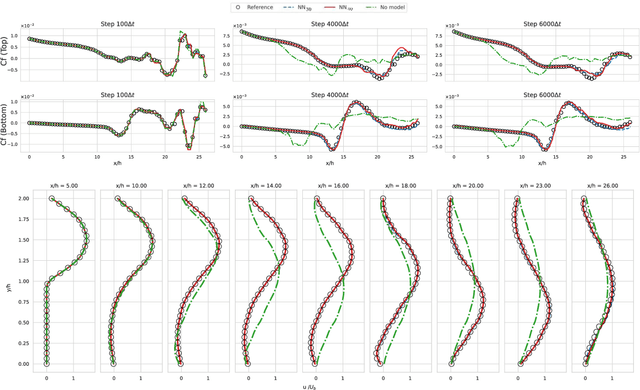
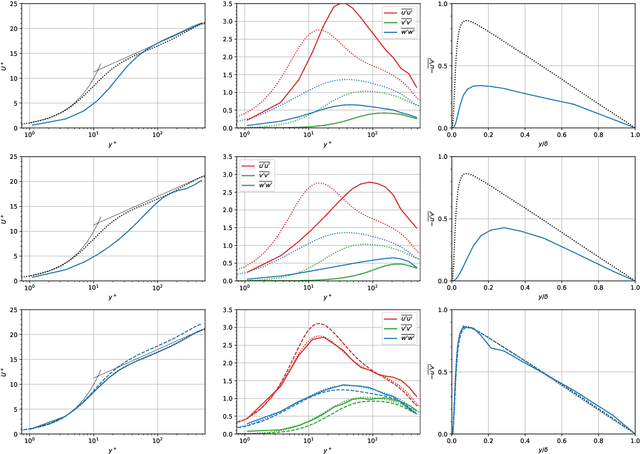
Abstract:Despite decades of advancements, the simulation of fluids remains one of the most challenging areas of in scientific computing. Supported by the necessity of gradient information in deep learning, differentiable simulators have emerged as an effective tool for optimization and learning in physics simulations. In this work, we present our fluid simulator PICT, a differentiable pressure-implicit solver coded in PyTorch with Graphics-processing-unit (GPU) support. We first verify the accuracy of both the forward simulation and our derived gradients in various established benchmarks like lid-driven cavities and turbulent channel flows before we show that the gradients provided by our solver can be used to learn complicated turbulence models in 2D and 3D. We apply both supervised and unsupervised training regimes using physical priors to match flow statistics. In particular, we learn a stable sub-grid scale (SGS) model for a 3D turbulent channel flow purely based on reference statistics. The low-resolution corrector trained with our solver runs substantially faster than the highly resolved references, while keeping or even surpassing their accuracy. Finally, we give additional insights into the physical interpretation of different solver gradients, and motivate a physically informed regularization technique. To ensure that the full potential of PICT can be leveraged, it is published as open source: https://github.com/tum-pbs/PICT.
PRDP: Progressively Refined Differentiable Physics
Feb 26, 2025Abstract:The physics solvers employed for neural network training are primarily iterative, and hence, differentiating through them introduces a severe computational burden as iterations grow large. Inspired by works in bilevel optimization, we show that full accuracy of the network is achievable through physics significantly coarser than fully converged solvers. We propose Progressively Refined Differentiable Physics (PRDP), an approach that identifies the level of physics refinement sufficient for full training accuracy. By beginning with coarse physics, adaptively refining it during training, and stopping refinement at the level adequate for training, it enables significant compute savings without sacrificing network accuracy. Our focus is on differentiating iterative linear solvers for sparsely discretized differential operators, which are fundamental to scientific computing. PRDP is applicable to both unrolled and implicit differentiation. We validate its performance on a variety of learning scenarios involving differentiable physics solvers such as inverse problems, autoregressive neural emulators, and correction-based neural-hybrid solvers. In the challenging example of emulating the Navier-Stokes equations, we reduce training time by 62%.
Optimization Landscapes Learned: Proxy Networks Boost Convergence in Physics-based Inverse Problems
Jan 27, 2025Abstract:Solving inverse problems in physics is central to understanding complex systems and advancing technologies in various fields. Iterative optimization algorithms, commonly used to solve these problems, often encounter local minima, chaos, or regions with zero gradients. This is due to their overreliance on local information and highly chaotic inverse loss landscapes governed by underlying partial differential equations (PDEs). In this work, we show that deep neural networks successfully replicate such complex loss landscapes through spatio-temporal trajectory inputs. They also offer the potential to control the underlying complexity of these chaotic loss landscapes during training through various regularization methods. We show that optimizing on network-smoothened loss landscapes leads to improved convergence in predicting optimum inverse parameters over conventional momentum-based optimizers such as BFGS on multiple challenging problems.
Light Transport-aware Diffusion Posterior Sampling for Single-View Reconstruction of 3D Volumes
Jan 09, 2025



Abstract:We introduce a single-view reconstruction technique of volumetric fields in which multiple light scattering effects are omnipresent, such as in clouds. We model the unknown distribution of volumetric fields using an unconditional diffusion model trained on a novel benchmark dataset comprising 1,000 synthetically simulated volumetric density fields. The neural diffusion model is trained on the latent codes of a novel, diffusion-friendly, monoplanar representation. The generative model is used to incorporate a tailored parametric diffusion posterior sampling technique into different reconstruction tasks. A physically-based differentiable volume renderer is employed to provide gradients with respect to light transport in the latent space. This stands in contrast to classic NeRF approaches and makes the reconstructions better aligned with observed data. Through various experiments, we demonstrate single-view reconstruction of volumetric clouds at a previously unattainable quality.
APEBench: A Benchmark for Autoregressive Neural Emulators of PDEs
Oct 31, 2024Abstract:We introduce the Autoregressive PDE Emulator Benchmark (APEBench), a comprehensive benchmark suite to evaluate autoregressive neural emulators for solving partial differential equations. APEBench is based on JAX and provides a seamlessly integrated differentiable simulation framework employing efficient pseudo-spectral methods, enabling 46 distinct PDEs across 1D, 2D, and 3D. Facilitating systematic analysis and comparison of learned emulators, we propose a novel taxonomy for unrolled training and introduce a unique identifier for PDE dynamics that directly relates to the stability criteria of classical numerical methods. APEBench enables the evaluation of diverse neural architectures, and unlike existing benchmarks, its tight integration of the solver enables support for differentiable physics training and neural-hybrid emulators. Moreover, APEBench emphasizes rollout metrics to understand temporal generalization, providing insights into the long-term behavior of emulating PDE dynamics. In several experiments, we highlight the similarities between neural emulators and numerical simulators.
Flow Matching for Posterior Inference with Simulator Feedback
Oct 29, 2024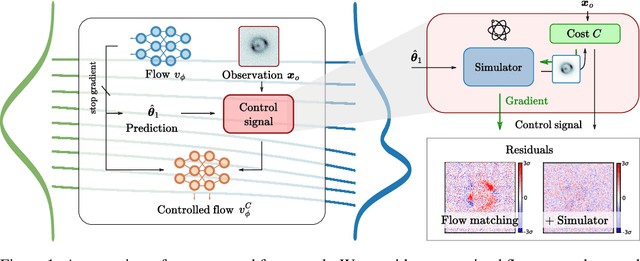
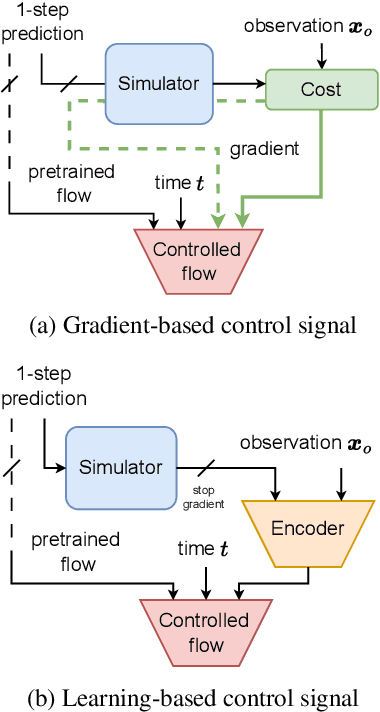
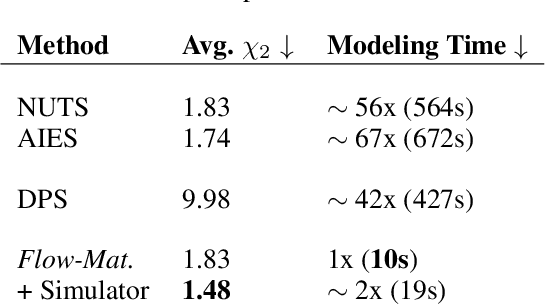

Abstract:Flow-based generative modeling is a powerful tool for solving inverse problems in physical sciences that can be used for sampling and likelihood evaluation with much lower inference times than traditional methods. We propose to refine flows with additional control signals based on a simulator. Control signals can include gradients and a problem-specific cost function if the simulator is differentiable, or they can be fully learned from the simulator output. In our proposed method, we pretrain the flow network and include feedback from the simulator exclusively for finetuning, therefore requiring only a small amount of additional parameters and compute. We motivate our design choices on several benchmark problems for simulation-based inference and evaluate flow matching with simulator feedback against classical MCMC methods for modeling strong gravitational lens systems, a challenging inverse problem in astronomy. We demonstrate that including feedback from the simulator improves the accuracy by $53\%$, making it competitive with traditional techniques while being up to $67$x faster for inference.
ConFIG: Towards Conflict-free Training of Physics Informed Neural Networks
Aug 20, 2024Abstract:The loss functions of many learning problems contain multiple additive terms that can disagree and yield conflicting update directions. For Physics-Informed Neural Networks (PINNs), loss terms on initial/boundary conditions and physics equations are particularly interesting as they are well-established as highly difficult tasks. To improve learning the challenging multi-objective task posed by PINNs, we propose the ConFIG method, which provides conflict-free updates by ensuring a positive dot product between the final update and each loss-specific gradient. It also maintains consistent optimization rates for all loss terms and dynamically adjusts gradient magnitudes based on conflict levels. We additionally leverage momentum to accelerate optimizations by alternating the back-propagation of different loss terms. The proposed method is evaluated across a range of challenging PINN scenarios, consistently showing superior performance and runtime compared to baseline methods. We also test the proposed method in a classic multi-task benchmark, where the ConFIG method likewise exhibits a highly promising performance. Source code is available at \url{https://tum-pbs.github.io/ConFIG}.
 Add to Chrome
Add to Chrome Add to Firefox
Add to Firefox Add to Edge
Add to Edge